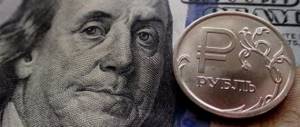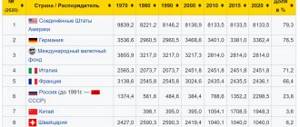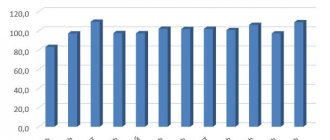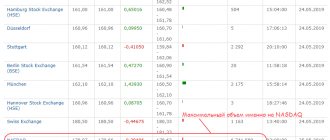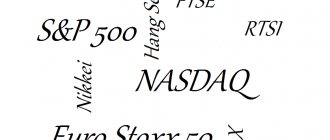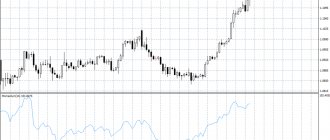In simple terms, currency intervention This is a regular purchase or sale of national currency. This purchase/sale is carried out by representatives of the Central Bank of the country in which this currency operates. The most basic and first goal of currency intervention is exclusively the interests of the country, namely its economic sphere. We can say that currency intervention is a kind of lever in the sphere of regulating the country's monetary policy.
In this case, there should always be drops and rises in price when buying/selling a currency. For this, the Central Bank uses certain schemes.
So, in order to increase the exchange rate of its own currency, Central Bank employees need to sell as much foreign currency as possible. At the same time, they buy all the national currency. In this way, they can significantly reduce the demand for all foreign currency. You mean, the demand for the ruble will immediately increase.
A completely opposite situation occurs when the national currency depreciates. Simply put, the Central Bank buys as much foreign currency as possible and tries to sell all the national currency. Actually, the exchange rate of foreign currency should rise, and the domestic currency should fall.
↑ to contents
The concept of currency intervention and why it is carried out
Foreign exchange interventions are a monetary policy tool. It is used by central banks to strengthen or weaken the exchange rate of the national currency through the purchase or sale of foreign currency on the open market. The goal is not simply to “move” the rate up or down. This is a way of monetary regulation of the economy as a whole. The intervention method is based on the law of supply and demand, and therefore is of a market nature.
Like any other product, currency, the less it is on the market, the more expensive it is. And vice versa: the more, the cheaper.
There are other methods of regulating the exchange rate. For example, when the Central Bank wants to increase the ruble exchange rate, it issues large volumes of federal loan bonds and sells them on the market. This increases investor demand for rubles, which pushes the rate up. But we consider cash injections as interventions, when the Central Bank prints rubles or “throws” dollars from its reserves onto the market. By the way, despite the fact that the dollar has the same share as the euro in the structure of the reserves of the National Wealth Fund (NWF), foreign exchange interventions are denominated in American currency. This is due to the fact that 60% of international payments are denominated in dollars (in euros - 20%, in yuan - 1.6%).
The main goals of foreign exchange interventions:
- Influence the balance of demand and supply of currency and thereby the ruble exchange rate;
- Control exchange rate volatility, which undermines the stability of the economy, irritates business, and undermines the financial system;
- To reassure foreign investors who leave the Russian market in the event of a sharp weakening of the ruble exchange rate;
- Replenishment of foreign exchange reserves of the government and the Central Bank.
Monetary measures to regulate exchange rates are used by all countries, but in different ways. For export-oriented economies (like Japan), it is important not to let their currency appreciate too much, as this reduces the competitiveness of their products. This gives rise to such a phenomenon as “currency wars”. An example is the US accusations against China, which is controlled by undervaluing the yuan against the dollar. There are countries that cannot influence the exchange rate of their own currency because they are members of economic unions such as the EEC and are subject to the decisions of the European Central Bank (ECB). This, in particular, is a burden for Italy and Greece, which before the introduction of the euro were accustomed to attracting investors and tourists through the cheap lira and drachma.
I also recommend reading:
Trust management: is there any benefit for the investor?
What is trust management and should you trust it?
What results do the interventions lead to?
The result of an intervention is most often a decrease or increase in the exchange rate, depending on the purpose for which it was carried out. Intervention is considered an extreme measure of influence on a state’s monetary system, so countries resort to it in rare cases when there is no other way out.
It is worth noting that currency interventions are practically not market methods. There are certain conditions for the intervention to be successful. One of these conditions is the huge reserve of financial resources of the Central Bank.
Types of foreign exchange interventions
There are two main types of interventions.
- Monetary (monetary) - the actual purchase or sale of foreign currency by the Ministry of Finance in favor of the Central Bank. Can be done in two ways:
- Direct intervention, when the Central Bank enters the market on its own behalf and announces it publicly;
- Hidden intervention, when the Central Bank acts through its “subordinates” - commercial banks, supplying them with liquidity through repo auctions.
- Verbal intervention is a statement from financial authorities to which investors react. It is used when the regulator needs to adjust market sentiment and move quotes in the desired direction. Verbal interventions may turn out to be fictitious according to the principle “promising does not mean marrying.” This method is used quite often, since it does not require real financial costs and is essentially limited to the spread of rumors. Typically, central banks voice their intentions and forecasts in advance. The most noticeable example is the statements of the US Federal Reserve System (FRS), by the tone and half-hints of which the world market detects the movement of the exchange rate of the main reserve currency. The difference between the Fed and the Central Bank of the Russian Federation is that the public rhetoric of the former has an impact on the global economy, while the statements of the latter are local in nature.
These information “stuffing” serve two purposes:
- form market positions in the right direction, when expectations are built into the price long before the actual actions of the regulator;
- prevent a market collapse due to sudden decisions for which investors and hedge funds are not prepared.
In terms of volume, interventions can be large-scale. For example, for Russia this is several billion dollars a day. They can also be point-specific, making a slight adjustment to the exchange rate dynamics. Of course, large infusions are more effective. But they also carry a greater risk: if the collapse is not prevented, the currency crisis could become uncontrollable. In this case, the reserves will be almost used up. This is what happened in the fall of 2014.
False Dmitry I
At the beginning of 1604, an impostor appeared who pretended to be the miraculously saved son of Tsar Dmitry. In history he is known as False Dmitry I. In April 1604, he converted to Catholicism. For recognition of the right to the Russian throne and help from Poland, False Dmitry promised to give Sigismund the Seversky and Smolensk territories after the accession of the Polish-Lithuanian Commonwealth. At the same time, the impostor’s army entered Russian lands. Some Russian cities (Putivl, Chernigov, Moravsk) surrendered to False Dmitry without a fight. The Moscow militia that opposed him F.I. Mstislavsky was defeated near Novgorod-Seversky.
On June 20, 1605, amid festive popular rejoicing, False Dmitry entered Moscow. On July 18, Empress Martha, who arrived in the capital, recognized the adventurer as her missing son. On July 30, he was crowned on the throne.
After his accession to the throne, the impostor attempted reforms with the aim of reorienting Russian policy towards Poland. But part of the boyars, thanks to the spread of rumors from Prince Vasily Shuisky, did not believe him. Thanks to the investigation of Pyotr Basmanov, the conspiracy was discovered and on June 23, 1605, Vasily Shuisky received a death sentence, but was pardoned at the scaffold itself. On the night of May 17, 1606, the impostor False Dmitry I was killed by the boyar opposition as a result of an uprising against representatives of the Polish-Lithuanian Commonwealth who came to Moscow.
For a while, boyar Vasily Shuisky came to power. But in the south of the country in 1606-1608. A peasant uprising took place under the leadership of Ivan Bolotnikov, which gave impetus to the “thieves” movement.
How currency interventions were used in Russia
Since 1995, the Central Bank has used the so-called currency corridor in its practice. It determined the upper and lower limits of the dollar-ruble exchange rate. As soon as the rate approached the upper limit, the regulator threw several billion dollars onto the market, thereby sterilizing the toxic ruble mass. When approaching the lower limits, dollars were withdrawn from the market in the amount that ensured a return to the right direction. In 2005, the concept of a “dual-currency basket” was introduced, which included the weighted average exchange rate of the euro and dollar.
I also recommend reading:
Reviews about binary options: a scam or a way to make money?
Binary options: honest analysis and reviews from real traders
For the financial system, especially for its banking sector, what is important is not so much the exchange rate itself as its stability and predictability. Sooner or later the economy will adapt to the high dollar exchange rate. But sharp jumps in volatility create uncertainty in the market, even to the point of panic. Investors, banks and even industrial enterprises direct free liquidity not into business, but into the foreign exchange market. An example is currency speculation at the height of the crisis of 2014–2016, when, as a result of joint actions of the government, the Central Bank (and somewhere Rosneft), the dollar rose to 77 rubles (in exchange offices - up to 90).
Until November 2014, the Central Bank put out fires in the foreign exchange market by dousing them with dollars. Over the 11 months of 2014, more than $70 billion was spent for these purposes. With high oil prices, such actions did not lead to the depletion of reserves. But we remember that in the same year, black gold fell in price by almost 2 times. The regulator was actually wasting supplies faster than it was replenished. Under the threat of an absolute loss of foreign exchange reserves due to interventions, the Central Bank took a bold step and established a floating exchange rate for the ruble. Since then, foreign exchange interventions have not been carried out in the same form, and the currency corridor was abolished. The Central Bank even stopped publishing relevant statistics on its website.
Formally, the ruble was allowed to float freely and currency interventions are no longer officially called that. However, in reality they exist, they just took on a different form - the purchase of foreign currency by the Ministry of Finance for the Central Bank. They have the same impact on the financial system, investment and business climate. At high oil prices (anything over $40), dollar liquidity is used to replenish the National Welfare Fund. If prices fall, reserves will be printed and the purchase of foreign currency for them will stop.
Only one of the declared goals has been removed from the list of priorities - maintaining the ruble exchange rate with large-scale foreign exchange injections. A strong ruble is not such an attractive prospect for the government. Moreover, it is not interested in strengthening the Russian currency. Devaluation makes it easier to execute the budget and fulfill social obligations denominated in the national currency. This is also beneficial for energy exporters, who receive revenue in expensive dollars, and pay taxes and salaries in cheap rubles.
The second effective means of regulating the ruble exchange rate is the key rate. In the event of a collapse of the ruble, the Central Bank sharply raises the rate, making funding for currency speculation too expensive. This was done in December 2014, when the rate “soared” from 10.5 to 17% overnight. This caused a shock on the market, but the collapse of the ruble was prevented. After all, the dollar exchange rate at that time was limited only by imagination.
I also recommend reading:
Quote charts: educational program for a beginner
How to read quote charts correctly
Implications for the trader
For a trader trading in the foreign exchange market, it is very important to monitor official statements regarding upcoming interventions. After all, otherwise he may end up in a deal directed against such a colossus as the country’s central bank with its huge reserves.
In addition, timely information about an upcoming VI can allow a trader to “ride the wave”, making money on changes in the exchange rate. And a change in course, as a rule, inevitably follows statements of this kind, even if they are not followed by real actions on the part of the Central Bank (in the case, for example, of verbal VI). Another thing is that verbal intervention is always followed by an inevitable rollback, while real intervention has every chance of resulting in a new trend (but there are no guarantees here).
Information about upcoming joint interventions on the part of a number of states is generally a bonanza for any currency trader. After all, this kind of VI, as a rule, is always doomed to success and a trader can almost guarantee making huge money on them. However, information of this kind, in almost all 100% of cases, belongs to the category of insider information (it is not published in the media and is known only to a narrow circle of people).
How to use information on the volume of foreign exchange interventions
Let's determine what foreign exchange interventions affect:
- for inflation, that is, an increase in the cost of goods and services;
- on the inflow or outflow of foreign capital, which earns money in Russia on ruble instruments and due to the difference in interest rates;
- on decisions on the key rate of the Central Bank, and through it – on investment and business activity in the economy;
- on the cost of money and, as a result, credit demand from the population and companies;
- on the availability and volume of liquidity in the financial market.
All of the above parameters must be taken into account when planning investments. For example, ruble inflation determines the share of foreign exchange instruments in the portfolio. The cost of borrowing affects the effectiveness of investing in a real business. The balance of inflow and outflow of foreign capital is a factor in the market value of shares, and the key rate is the profitability of investments in OFZs.
Now the regulator’s foreign exchange interventions are aimed in one direction – to buy up the dollar and against the ruble. This makes it possible to fill gold and foreign exchange reserves, but because of this, the dollar exchange rate remains at a high level. Of course, there are other factors that can affect the strengthening of the national currency. Let's look at them from the point of view of prospects for the Russian foreign exchange market. And we ourselves will give the most likely answer.
- Structural reforms and reduction in the share of the public sector (not expected in the foreseeable future);
- Growth in oil prices (does not depend on the will of the government and the Central Bank);
- Improving the external environment and investment climate (unrealistic under sanctions).
Since these factors are beyond the control of the financial authorities, there are only two methods left in their arsenal - currency intervention and the key rate.
Specifics of application of interventions
Two features of interventions can be distinguished, on which their effectiveness and duration of consequences greatly depend:
- sterilization - ensuring the issue of currency with government debt obligations, leveling the direct impact on the domestic foreign exchange market. Unsterilized interventions are more effective over a long period of time because they directly affect both the domestic and foreign foreign exchange markets;
- direction of movement - the most effective intervention is “on the market”, allowing the rate to change sharply to the required parameters and maintain them for a long time. Interventions against market trends have only a short-term effect.
INTERVENTION is the economic impact of one entity on the affairs and actions of another, carried out by penetrating into the sphere of these actions, investing and placing their own funds in it.
[p.276] INTERVENTION is the economic impact of one entity on the affairs and actions of another, carried out by penetrating into the sphere of these actions, investing and placing their own funds in it. Typically, intervention operations are carried out by central banks, the treasury and
ECONOMIC INTERVENTION - intervention of one country in the economic sphere of another. Economic intervention is carried out, as a rule, by influencing the exchange rate or the price of exported goods. [p.257]
In the end, these concessions to the spontaneous movement in conditions of complete devastation led to extreme measures - the establishment of military communism itself - a strictly centralized socio-economic system, when the state concentrated in its hands almost all labor, financial and material and technical resources, forcing them to work on the principles military subordination. The country was declared a single military camp (later, in the spring of 1921, V.I. Lenin called the existing economic and political system “war communism”). This second period is from the autumn of 1918 to the winter of 1919-1920. — coincided with the unfolding of the Civil War and intervention. The economic situation in the country was terrifying, and all government measures during this period were, justifiably, of an emergency, forced nature. [p.170]
The narrow market space for domestic entrepreneurs and at the same time the sudden “interventions” of imported goods that have been repeated in recent years often lead to an imbalance of supply and demand in the domestic market, which, in turn, casts doubt on the feasibility of innovation processes due to the difficulties in realizing the final results. Therefore, the risk factor from a decrease in market demand and interest in the final results plays an important role in assessing the economic feasibility of large-scale investments in the republic. [p.7]
Followers of this concept recognize its vulnerability. For example, the American economist G. Johnson came to the conclusion that the response of the balance of payments to changes in the exchange rate is slow, and freely fluctuating exchange rates cannot weaken speculative capital flows. According to J. Weiner, even in a world of free market prices it is impossible to imagine a foreign currency market in which the state does not interfere directly or indirectly. Completely freely fluctuating rates are probably unattainable if determined precisely.2 This recognizes the inevitability of government intervention in currency relations. The instability of floating exchange rates undermines the confidence of economic agents. Therefore, in practice, preference is given to the regime of regulated floating exchange rates. The meetings of the seven leading countries confirmed this principle. The concept of exchange rate fluctuation limits has been introduced. The stock exchange crisis of 1987 again (as in the mid-70s) revealed the need for collective currency intervention by the United States, Germany, and Japan to stabilize the dollar and other leading currencies. [p.59]
Based on their own analysis and the assessments of other banks and brokers, dealers develop a direction for foreign exchange transactions, a preference for a long or short position in the particular currency in which they transact. As new information appears throughout the day, dealers’ assessment of foreign exchange market trends and the direction of foreign exchange transactions they choose may change several times. In this case, commercial demand, incoming information about economic and political events, currency intervention by central banks and other factors play a role. [p.354]
Foreign exchange interventions by central banks are aimed at counteracting the depreciation of the national currency or, conversely, its increase. However, it should be noted that foreign exchange interventions can be an effective method of influencing exchange rates in the short term, since it is not only through interventions that it is impossible to ensure exchange rates that correspond to basic economic and financial indicators. The most effective are currency interventions accompanied by corresponding measures in the field of general economic policy of the state. [p.472]
CURRENCY MARKETS - a system of socio-economic and organizational relations for the purchase and sale of foreign currencies and payment documents in foreign currencies. CURRENCY MARKETS serve as a mechanism through which international settlements are made in foreign trade, tourism and services, capital movements and other settlements involving the purchase and sale of foreign currency by its payer or recipient. With the help of CURRENCY MARKETS, currency risk insurance, diversification of foreign exchange reserves, and foreign exchange intervention are also carried out. In conditions of instability of the currency system and sharp fluctuations in exchange rates, speculative foreign exchange transactions that do not have a commercial basis and are designed to make a profit from changes in exchange rates have sharply increased. Speculative transactions in volume far exceed foreign exchange transactions servicing international settlements. The main subjects in the foreign exchange markets are large transnational banks that carry out transactions around the clock through a network of their branches in different countries with the widespread use of communications and computers. [p.32]
The current exchange rate system is best described as fluctuating exchange rates—fluctuating exchange rates with occasional foreign exchange intervention by central banks to stabilize or change the rate. As economic conditions change among countries, exchange rates need to be constantly adjusted to avoid permanent balance of payments deficits or surpluses. Typically, major trading countries allow their exchange rates to fluctuate to equilibrium levels based on supply and demand on currency exchanges. The result is markedly greater volatility in exchange rates than during the Bretton Woods era (see International Perspective 38-2). [p.856]
It was quite effective, since despite the extremely difficult financial situation inherited from Tsarist Russia, the Civil War, and foreign military intervention, the Soviet state managed to create a fairly powerful economic potential before the war with Nazi Germany, to win this war in a relatively short time restore the national economy destroyed by the war. [p.36]
In our country, administrative management of the economy was established at the end of 1918, when the civil war and foreign intervention began. On November 30, 1918, the Council of Workers' and Peasants' Defense was created, which became the main military-economic and planning center. Defense needs required centralization of the country's administration. The surplus appropriation system was introduced (all surplus food was taken from the peasants). Industry did not produce goods for the population, and economic relations became naturalized. Universal labor conscription was established. The leadership of industry was concentrated in the hands of the main departments of the All-Russian Council of National Economy. They deprived enterprises of any independence, provided them with material resources in a directive manner and sold finished products. [p.495]
Foreign exchange intervention is considered a temporary measure, since foreign exchange reserves cannot be sold to an economically unsafe minimum; they may dry up, which will lead, for example, to destabilization of the national currency, increased distrust of creditors and other similar consequences. Limiting foreign economic transactions is also advisable only up to a certain limit, after which these measures become a barrier to the country’s participation in the international division of labor. Measures 3 and 4 are more effective. They usually determine the level of optimality of international economic relations. Thus, a restrictive monetary policy can ensure a reduction in the consumption of imported goods and eliminate the imbalance of supply and demand in the foreign exchange market. At the same time, it leads to a decrease in money supply, an increase in interest rates, and, consequently, to an influx of capital into the country and the formation of a surplus in this part of the balance of payments. [p.270]
We are, of course, talking primarily about a transition period, when society and the economy are still far from stabilizing, the market has not been formed, and the public consciousness sees foreign investments as economic intervention with the aim of enslaving the country, turning it into a raw material appendage, etc. [p.461]
There are different points of view about who should carry out these commodity purchases and commodity interventions - private individuals or the state. Proponents of government intervention believe that the government has an advantage over private individuals both in terms of the availability of financial resources and the availability of more complete economic information. Therefore, it can more effectively and accurately influence [p.197]
As a result of the unjustified activities carried out in the period 1992-1998. Without a detailed consideration of the economic mechanism of the functioning of enterprises, the conditions of their economic activity were shifted to the area of unprofitability for most enterprises. In parallel with this, the intervention of foreign goods, the production of which is based on more modern technology and has a number of quality advantages, significantly paralyzed the demand for domestic products, reduced the real sales volume of K, which led in many enterprises to non-compliance with the law of mass production (an unacceptable decline in the volume of output of K ). [p.73]
All this is in one way or another connected with a simplified interpretation of the place and role of the state in the development process. Its excessive, often incorrect interference in economic processes, bureaucratic slingshots, and irrepressible craving for the redistribution of resources and control over the daily economic activities of market entities have slowed down the development of full-fledged private entrepreneurship and modern market institutions in many countries. Such interventions, distorting the structure of production and prices, contributed to their separation from the real needs of society, provided by effective demand, and accordingly influenced the general direction of investment. As a result, market equilibrium was undermined, competition was hampered, and thus the formation of mechanisms that stimulate innovation. [p.86]
Military-political intervention is the open or disguised intervention of some states in the internal affairs of another state with the aim of changing the social and political system, the geopolitical situation in the region, suppressing the revolutionary and national liberation movement, seizing territory, establishing their political dominance, economic enslavement, acquiring privileges and so on. Such military-political intervention acts as aggression. [p.100]
Economic intervention is a set of measures to forcibly change market conditions, i.e. the current state of the economy, to achieve set goals in the short term and long term. Such measures can lead to changes in the existing state of the market both at the micro level (changes in the balance of power between companies ), and at the macro level (national changes in the economy), to a regrouping of market forces, changes in trends in its development. [p.100]
Economic intervention can be internal - carried out by forces that are part of a given national economy, and external - carried out by forces that are part of the economy of another country. [p.100]
Internal economic intervention can be carried out by the government, the central bank, a large commercial bank or a group of commercial banks, a financial-industrial group (FIG), a large corporation and their alliances. [p.100]
External economic intervention can be carried out by governments, central banks, international commercial banks, financial industrial groups, international corporations and their alliances. For example, the government can conduct a commodity intervention - a massive sale of consumer goods from reserves prepared in advance in order to bring down rush demand and prevent a sharp increase in market prices, which is used as one of the means of regulating and ensuring stability of the market, prices, and preventing crisis situations in the markets. [p.100]
The most important feature of the Jamaican monetary system is the instability of international payments due to constant fluctuations in the exchange rates of individual countries, which forces all participants in international economic relations to insure currency risks, resorting to significant expenses. Countries are also forced to spend money to maintain the exchange rates of their currencies through foreign exchange intervention. The IMF, which received the authority to supervise the foreign exchange [p.168]
ECONOMIC INTERVENTION (from Latin inter-ventio - intervention) - the economic impact of one subject on the affairs and actions of another, carried out through penetration into the sphere of these actions, investments and placement of own funds in it. Typically, intervention operations are carried out by central banks and treasuries through the massive sale or purchase of currency, securities, and the provision of loans in order to normalize the state of the financial system. [p.119]
After adoption by the UN General Assembly in 1965. Declarations on the inadmissibility of interference in the internal affairs of states, on the protection of their independence and sovereignty, condemning all forms of intervention, economic intervention began to take on other, more civilized forms. Od-[p.593]
The concept of an international minimum standard for the treatment of aliens has often been used in the past to secure a privileged position for foreigners in economic matters (referring in particular to the exploitation of natural resources) and to justify military intervention in exporting countries oil. For this reason, the content and applicability of certain international standards to foreign persons have been questioned by some countries in multilateral forums2. [p.68]
Fearing an uncontrollable fall in the value of the dollar, the United States took the initiative to conduct a joint G5 currency intervention in 1985. Thus, the United States shifts the burden of its troubles to other countries. In the 90s, a long period of economic growth in the United States, a massive structural restructuring of the economy, and the elimination of the budget deficit returned the country to world leadership, which was lost under the pressure of a uniting Europe and the pressure of the countries of the Asia-Pacific region led by Japan. The strengthening of the dollar's position in the late 90s was facilitated by the crisis in the stock and currency markets of Southeast Asian countries and a temporary drop in the exchange rate of the yen, unprecedented in 8 years. [p.91]
Currency intervention began to be used in the 19th century. For example, the State Bank of Russia and the Austro-Hungarian Bank resorted to it to maintain the exchange rate of the national currency. After the abolition of gold monometallism, currency intervention became widespread. In the context of the global economic crisis in 1929-1933. Central banks used foreign exchange intervention to depreciate their currencies to facilitate currency dumping. [p.186]
Member countries can use their existing SDR reserves without political or economic obligations. IMF members can, in case of financial need, buy other currencies with SDR. In this case, they contact the IMF, which determines which countries participating in the SDR system can be purchased from and organizes the exchange process. Exchange rules (designing) are established by the IMF and registered in the Fund's Charter. It is considered unacceptable to use SDR during design only for the purpose of changing the structure of the country’s reserves, i.e., without the intended use of the purchased currencies. SDRs cannot be directly used for interventions in foreign exchange markets, but must first be exchanged into some currency in such cases. Since 1987, no design transactions have taken place. [p.539]
One cannot ignore the concept that M. S. Vselensky put forward in his book Nomenclature. According to Vselensky, in states like the USSR, there was state-monopoly feudalism). From a purely theoretical point of view, Voslensky’s concept does not stand up to criticism. It is enough to note that the key point in its justification is the assertion that state-monopoly feudalism was preceded (at least in those countries where states similar to the USSR did not arise as a result of foreign intervention) by a feudal formation (in particular, Voslensky insists that feudalism as socio-economic formation, as a system, existed in tsarist Russia even under Nicholas II (70). Meanwhile, already in the 19th century in the Russian Empire, feudalism as a method of production did not exist (as we have already said, serfdom brought to slavery was a phenomenon of the ascending capitalist mode of production. The author of these lines is inclined to think that already in the first half of the 18th century in Russia it was unambiguous and irreversible capitalist relations of production prevailed (71) therefore, the socio-economic formation based on it did not exist. It makes no sense to say that feudalism as a mode of production (by definition, based on pre-industrial productive forces) and formation was resurrected in Russia in the first half of the 20th century, during the period of industrialization, even if the production relations that prevailed in states like the USSR are similar in in their main features into feudal ones - all the same, having arisen at a qualitatively new stage in the development of productive forces, they are inherent in some other formation. (In this regard, let us once again emphasize the Asian
This announcement was made at the Plaza Hotel in New York City, hence the name of the Plaza Agreement. Following this, the Louvre Agreement was adopted at the Louvre in Paris, reaffirming the basic principles proclaimed at the Plaza Hotel. The large number of official statements still emerging on this matter shows that, in the main, the G5 countries have met their stated targets of stabilizing exchange rates to planned levels. Some economists believe this is a significant overestimation. The group includes Michael Bordo of Rutgers University and Anna Schwartz of the National Bureau of Economic Research. In their opinion, central bank interventions had little effect, causing disruptions in the functioning of foreign exchange markets and additional risk of losses. [p.792]
The modern currency market, which is characterized by periodically alternating periods of increased volatility (frequency and magnitude of changes) of prices and their relative stability, developed in the twentieth century. Until the mid-1930s, London was the leading center for foreign exchange trading, and the British pound was the currency for settlements and the creation of foreign exchange reserves. Since currencies were traded by telex or telegraph at the time, the British pound was commonly referred to as "able". After the Second World War, when the UK economy suffered great damage, and the United States was the only industrialized country not to suffer economically from the war, the US dollar, in accordance with the Bretton Woods Treaty (1944) between the USA, Great Britain and France, became a reserve currency for all capitalist countries with a strict artificial peg of their currencies to the US dollar (the creation of currency corridors, which were supposed to be ensured by the central banks of the respective countries through interventions or currency purchases). In turn, the US dollar was pegged to the cost of gold at the rate of 35 [p.5]
The Bank of Canada is an independent central bank that successfully manages its currency. Thanks to the strong economic relationship between Canada and the United States, the Canadian dollar is closely tied to the US dollar. The Canadian bank is more likely than other G7 central banks to intervene to support its dollar. The Bank changed its intervention policy in 1999 after discovering that its previous mechanical intervention approach of US$50 million at the firm previous closing price had not produced the expected result. [p.25]
G7 intervention in 1987 In 1987 The industrialized countries of the Group of Seven - the United States, Germany, Japan, Great Britain, France, Italy and Canada - agreed to stabilize the value of the dollar. In the previous two years, the value of the dollar had declined rapidly due to America's sizable trade deficit. Although the US trade deficit remained large, these countries concluded that a further decline in the dollar could harm economic growth in the G7 countries. Therefore, they purchased a large number of dollars to ensure that their value was maintained. Since 1987, G7 countries have periodically intervened in foreign exchange markets to stabilize the values of currencies. [p.856]
European Monetary System (EMS) The system officially began operating on May 13, 1979. Any European country with particularly close economic and financial ties to the European Union can participate in exchange rate setting and intervention mechanisms. The purpose of the system is to create an area of currency stability in Europe through the implementation of certain policies for setting exchange rates, lending and moving resources, aimed at eliminating the impact of currency instability on the process of effective integration in the European Community. Great Britain joined the European Monetary System in October 1990 [p.121]
Good economic data from Japan did not support the Yen. This event was caused by the reluctance of the Japanese authorities to see the strengthening of the national currency. According to officials, excessive strengthening of the yen is harmful to the country's economy at this stage. In other words, threats of currency intervention moved the USD/JPY pair upward. The preliminary value of the gross domestic product (GDP) index in Japan was +0.7% for the third quarter of 2002, +3.0% for the year. The indicator exceeded the average forecast of economists of +0.5%, and the previous value was revised upward. Private sector consumption rose 0.8% in the third quarter. The final value of the industrial production index for September was -0.1% for the month and +5.2% for the year (the forecast was -0.3% for the month and +4.9% for the year, the preliminary value was -0.3% for the year month, +4.9% per year). The index of orders in the field of mechanical engineering in Japan in September was +12.7% per month, -2.7% per year. The figure exceeded the value previously predicted by economists by more than twice. Economists note that Japan's economy has been growing for the third quarter. [p.76]
At the same time, the state is trying to neutralize the negative consequences of intensification, such as, for example, excessive urbanization of life, environmental degradation, etc. Neutralization of the negative consequences of intensification and economic growth is carried out by the state through strengthening its direct influence on the structure of the national economy - state support is used when closing unpromising industries and regions. E. F. Mizhenskaya. INTERVENTION (from Latin interventio - violent intervention), historically has military and political significance, but recently it has also acquired economic meaning. [p.100]
First Home Guard
In 1611, the 1st Militia of Prince Lyapunov, Trubetskoy and Zarutsky approached Moscow, which liberated Kitay-Gorod and the White City. A new government was approved, which aimed to eliminate divisions in the society of the nobility and collect taxes. But in the end, during internal strife, Lyapunov was killed, and the remaining troops besieged the Kremlin until the appearance of the 2nd Militia. As a result of the decentralization of power, the Ryazan region was devastated by the Crimean Tatars, Smolensk by the Poles, and northern cities by the Swedes (former allies).
Second Home Guard
In 1612, the 2nd Militia was convened under the leadership of princes Minin and Pozharsky: active opponents of the Polish intervention. They managed to liberate the strategically important Yaroslavl, where the militia held out for 4 months. At this time, there was a conflict between the princes regarding the collection of taxes, the convening of the Zemstvo Council, which never took place, as well as the opportunity to fight together with the Cossacks. But thanks to the wisdom of Archimandrite Dionysius and Abraham Palitsyn, the princes were reconciled. The date of signing the agreement was September 22. It laid the foundation for a new government consisting of Orders and Discharges. The troops of Hetman Khodkevich were defeated and the siege was lifted from the Moscow Kremlin.
Results of Polish and Swedish intervention
- After the accession of Mikhail Fedorovich, the stabilization of the political situation, the cohesion of the army, which liberated Moscow from the Polish interventionists, the territorial integrity of Russia was restored.
- Although some of the Russian regions were under the rule of Sweden and the Polish-Lithuanian Commonwealth and the role of foreign states remained, the struggle against external expansion was over.
- Significant changes took place in the domestic political sphere after foreign intervention:
- the role of the nobility and political elite of Posad increased;
- paths for the development of the state were outlined, autocracy was recognized as the optimal form of government;
- Centrifugal sentiments were in the air in society, the people wanted to unite under the rule of the Russian Tsar;
- individualistic aspirations were replaced by the idea of the “common good”;
Serfdom was declared the basis of the economy, Orthodoxy was declared the basis of ideology; social structure - class system.

